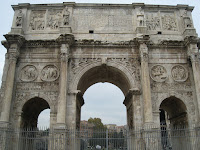These were the things we learned about in our history classes and we were finally seeing the reality of these stories. Normally I try to include some decent history lessons in my blogs, but there is waaaay too much to speak about (without boring you). So, I'll keep it brief - check out the pictures, click the links and if you want to discuss further, I'm always up to talk travel and history!Reminders of Ancient Rome's Splendor
Roman Forum

 What began as an ancient marketplace grew to be the economic, political, religious and social center of Ancient Rome 2000 years ago - so its a great place to start. Walking past the arches, temples, basilicas and other scattered ruins along Via Sacra (left) was surreal. After reaching its peak, the forum was left in ruins after barbarians sacked the city. Zack, Ryan and I rented audio guides and spent a few hours soaking in two millennium's worth of history.
What began as an ancient marketplace grew to be the economic, political, religious and social center of Ancient Rome 2000 years ago - so its a great place to start. Walking past the arches, temples, basilicas and other scattered ruins along Via Sacra (left) was surreal. After reaching its peak, the forum was left in ruins after barbarians sacked the city. Zack, Ryan and I rented audio guides and spent a few hours soaking in two millennium's worth of history.Palatine Hill
According to legend, the Palatine Hill is where Ancient Rome was founded. The story says that Romulus and Remus were nursed by a she-wolf in a cave upon the Palatine Hill. Romulus and Remus grew to found a city on the banks of the River Tiber; Romulus would later kill Remus and rule the city - hence the name "Rome". Recent excavations show that people have inhabited this hill since 1000 BC.
 The Palatine Hill, the centermost of the seven hills of Roma, overlooks the Roman Forum on one side and the ruins of the Circus Maximus (ENORMOUS stadium for chariot races that held approx. 200,000 spectators back in the day) on the other. During the ancient times, this was one of the most desirable pieces of real estate in the city. It was home to the Roman Emperors and has the ruins of multiple palaces with great views over the "centro storico" (historical city center). Zack and Ryan are shown (right) overlooking the Stadium of Domitian where fights, private hunts and other games took place.
The Palatine Hill, the centermost of the seven hills of Roma, overlooks the Roman Forum on one side and the ruins of the Circus Maximus (ENORMOUS stadium for chariot races that held approx. 200,000 spectators back in the day) on the other. During the ancient times, this was one of the most desirable pieces of real estate in the city. It was home to the Roman Emperors and has the ruins of multiple palaces with great views over the "centro storico" (historical city center). Zack and Ryan are shown (right) overlooking the Stadium of Domitian where fights, private hunts and other games took place.Arch of Constantine
Created in 315 AD, the large triumphal arch next to the Colosseum is dedicated to Emperor Constantine for his victory in the Battle of the Milvian Bridge in 312 AD - an extremely important event in shaping world history. The night before the battle, Emperor Constantine had a vision instructing him to put the Greek letters "chi-rho" - similar to Christ - on his shields. He vowed that if God gave him this unlikely victory, he would convert to Christianity. Constantine won the battle and ended Christian persecution in the Edict of Milan in 313 AD by declaring religious tolerance. Because of this freedom, Christianity would go on the become that dominant religion of the western world.
The Colosseum
Properly called the Flavian Amphitheater, it was built in 72 AD and named "Colosseum" for the colossal statue of Nero that was once adjacent to it. It is thought to have a capacity of approximately 50,000 spectators and has influenced the designs of our modern stadiums. Today, the Colosseum is a mere shell of its former glory - most of the stone was removed to build other monuments around the city during later times. However, it still remains a reminder of the cruel and violent fights and games that Roman spectators enjoyed nearly 2000 years ago. It is estimated that over 500,000 people and over 1,000,000 animals have died in this arena.
 The elaborate games included sea battles where the arena would be flooded or staged hunts where props of scenery were set up to simulate wildness as a humans were pitted against exotic animals. However, the most well known games were gladiatorial contests - battles to the death between criminals, prisoners of war or fighters seeking glory. Given the choice to be slaves or battle for their freedom, successful gladiators experienced popularity and riches - much like today's athletes. If you haven't seen the movie Gladiator, please stop reading now and go watch it...
The elaborate games included sea battles where the arena would be flooded or staged hunts where props of scenery were set up to simulate wildness as a humans were pitted against exotic animals. However, the most well known games were gladiatorial contests - battles to the death between criminals, prisoners of war or fighters seeking glory. Given the choice to be slaves or battle for their freedom, successful gladiators experienced popularity and riches - much like today's athletes. If you haven't seen the movie Gladiator, please stop reading now and go watch it...



No comments:
Post a Comment